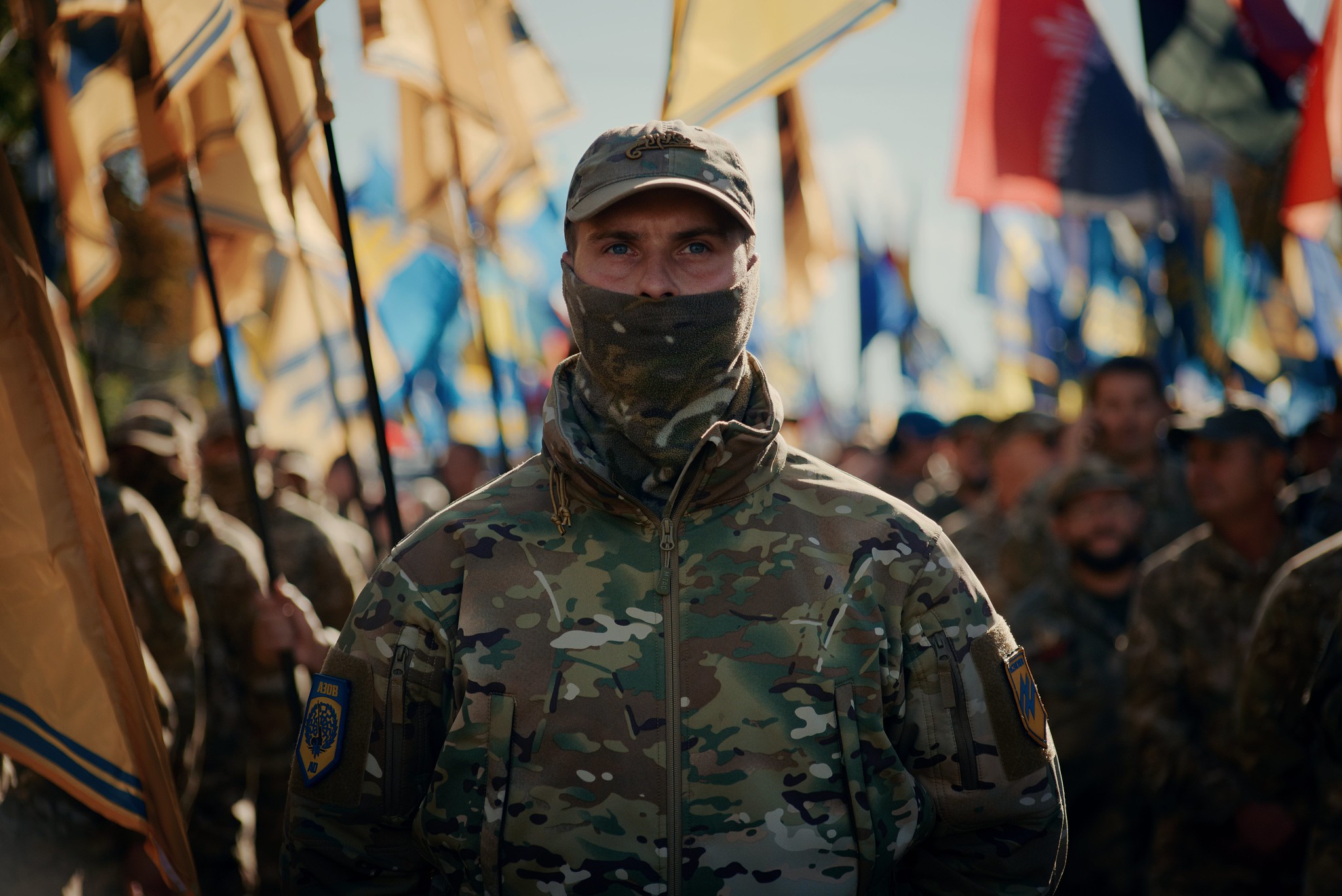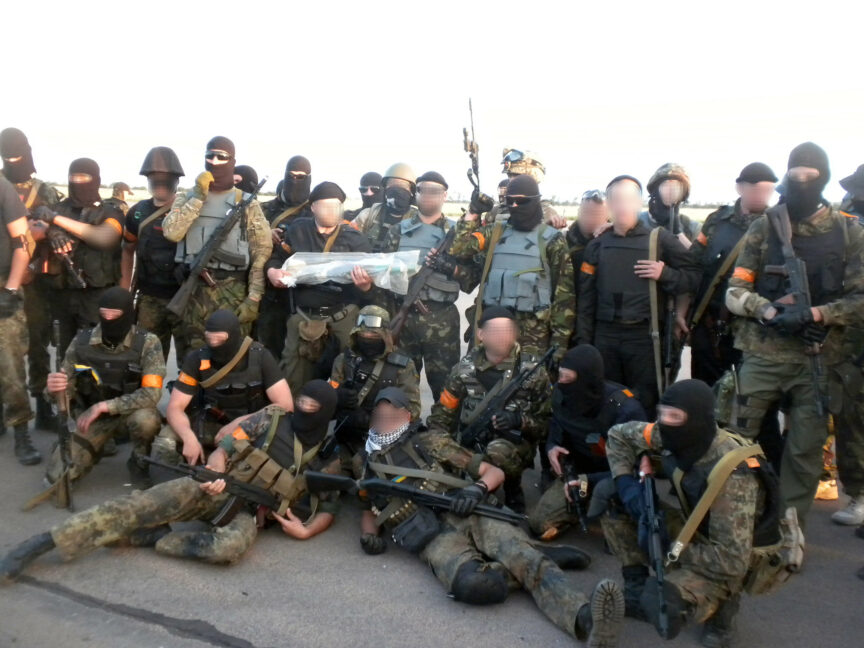The Far Right is Using the Ukraine Crisis to Cement Its Power

The geopolitical situation in Ukraine has been tense for months. Since last spring, Russia has sent 150,000 troops to Ukraine’s borders and last night, ordered some of them into two eastern regions. While the Ukrainian leadership has been sceptical about these doomsday predictions, criticising the western media’s fear-mongering, it has also stated that the country is ready for any eventuality.
The tensions have already destabilised Ukraine’s economy, and any further escalation is sure to do more damage – not to mention the potentially catastrophic loss of life. Yet for the Ukrainian far right, the current crisis is a massive opportunity.
Michael Colborne is a Canadian journalist who has lived in Ukraine and the author of a forthcoming book about Azov, the country’s most powerful far-right movement. Speaking to Novara Media, he says: “The far right and particularly the Azov movement are trying to take advantage of the current situation.”
One aspect of the group’s strategy which has received significant international media coverage are its civil defence trainings. These events, which usually span a few hours, involve Azov instructors showing civilians how to resist a potential ground invasion: handling weapons, taking cover, tactical medicine and so on.

The Azov movement was born in 2014 during the outbreak of the war in eastern Ukraine in order to fight Russian-backed rebels. Then a volunteer regiment, today Azov is part of Ukraine’s National Guard and part of a broad movement comprising a political party, civilian militia, publishing house, social centres, martial arts clubs and youth camps. While the movement tries to deny the violence or extremism of its ethnonationalist ideology, its leader has previously described Ukraine’s mission as “leading the world’s white nations in their last crusade, against semite-lead subhumanity.”
Electorally, however, the movement is marginal. When its political wing joined forces with several other far-right parties to participate in Ukraine’s most recent parliamentary elections in 2019, the bloc drew barely more than 2% of the vote. Yet Azov has friends in high places, particularly the Ukrainian security apparatus: the country’s long-serving interior minister, Arsen Avakov, who resigned last summer, is considered by experts a patron of the movement; a former Azov commander was until three months ago deputy chair of the national police. The current crisis could cement their position.
The civil defence trainings are nothing new, but something the far right has been engaged in since the war in 2014. In recent weeks, however, their frequency has increased, as part of an Azov campaign whose motto is “Don’t panic – prepare yourselves!” Since launching in early February, the campaign’s Telegram channel has announced trainings in over 20 Ukrainian cities.
How many participants come from the far right is hard to tell, says Colborne. While some certainly do, “others are pretty ordinary members of the public, who probably know Azov the regiment and either don’t know about its far-right nature or simply don’t care because their priority is to defend the country.”
“And that’s why, I think, what they’re doing now is clever, because they’re positioning themselves as – within the context of Ukraine right now – normal actors who have the best interests of the country in mind. As a strong no-nonsense, non-extreme movement that can step in where Ukraine’s failed politicians can’t.”
The influence of the Ukrainian far right is hotly contested among observers. While Russia’s propaganda machine likes to exaggerate it, Western media coverage often tends to understate it so as to avoid regurgitating Kremlin talking points. As a result, international coverage of Azov’s civil defence trainings has tended to describe them more as a manifestation of ordinary Ukranians acting in self-defence than as an example of Azov’s political strategy.
Yet the popular appeal of the trainings may be overstated. Videos posted to Azov’s social media show one Kiev training with several hundred participants, while another post boasts that “[m]edia from the whole world are writing about our campaign!” Yet this media coverage often focuses on the same few events and participants. “Western journalists have occupied all hotel rooms since January, waiting for the promised ‘imminent invasion’,” says Ukrainian sociologist Volodymyr Ishchenko, who has researched the country’s far right. “Now, they need to produce stories about the war.”
“Reporting that most people don’t believe in it, aren’t withdrawing money from their bank accounts or emptying supermarkets,” Ishchenko adds, “is not interesting. Marginal civil defence trainings play much better with the expected narrative.” By his estimation, patriotic marches organised by far-right groups have also seen relatively poor turnout.
To what degree Azov will be able to convert the current crisis into political capital is hard to predict, says Colborne. They’ve certainly failed to before: “In 2020 they also tried to take advantage of the pandemic by presenting their own volunteer corps as this helpful patriotic force, ready to step in when the government couldn’t.”
“But they dismissed that within a few months, because, I think, they realised that, despite the relative cost, they weren’t getting anything out of it in terms of improving their brand.”
The movement’s concern over its image probably also means that far-right volunteers from abroad won’t play as key a role in Azov as they did in the early phase of the war. When the conflict broke out in 2014, neo-Nazis from across Europe flocked to Ukraine to join both the Ukrainian and Russian sides. The presence of far-right fighters from abroad has been costly for Azov’s reputation. “Whereas in 2014 they were actively recruiting foreign help, this time they’re actively rejecting it,” says Colborne. According to him, the main determinant in Azov’s fate is whether Russia escalates.
“If there is renewed fighting in Donbas and the Azov regiment takes part in battle, shows itself defending the country, fights well and takes casualties, then, like in 2014, that would help to further improve their status in Ukrainian society.” War, after all, is what created the Azov movement: “Further war … would be an opportunity for them to be reborn.”
Volodya Vagner is a freelance journalist based in Sweden, covering culture and politics.


